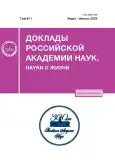ENDOGENOUS BRASSINOSTEROIDS ARE INVOLVED IN THE FORMATION OF SALT RESISTANCE OF PLANTS
- Autores: Kolomeichuk L.V.1, Danilova E.D.1, Murgan O.K.1, Sauchuk A.L.2, Litvinovskaya R.P.2, Khripach .А.2, Kuznetsov V.V.1,3, Efimova M.V.1
-
Afiliações:
- National research Tomsk State University
- Institute of Bioorganic Chemistry, National Academy of Sciences of Belarus
- Timiryazev Institute of Plant Physiology, Russian Academy of Sciences
- Edição: Volume 511, Nº 1 (2023)
- Páginas: 365-370
- Seção: Articles
- URL: https://journals.rcsi.science/2686-7389/article/view/135650
- DOI: https://doi.org/10.31857/S2686738923600164
- EDN: https://elibrary.ru/JDCWCH
- ID: 135650
Citar
Texto integral
Resumo
For the first time it was shown that potato plants responded to salt stress by changing the profile of endogenous brassinosteroids (BS). At the same time, a group of 6-keto-BS was identified, the content of which, unlike other analyzed groups of hormones, increased significantly during salinization. It was found that a 10-fold decrease in the level of endogenous BS in mutant Arabidopsis thaliana plants with impaired biosynthesis (det2) (or reception (bri1)) of phytosteroids leads to a decrease in their salt resistance, as evidenced by a decrease in the efficiency of photochemical processes of photosystem II (PSII) and inhibition of growth. The presented data confirm the idea of the involvement of endogenous BS in the formation of salt resistance of plants.
Palavras-chave
Sobre autores
L. Kolomeichuk
National research Tomsk State University
Email: nusy.l.d@gmail.com
Russian Federation, Tomsk
E. Danilova
National research Tomsk State University
Autor responsável pela correspondência
Email: nusy.l.d@gmail.com
Russian Federation, Tomsk
O. Murgan
National research Tomsk State University
Email: nusy.l.d@gmail.com
Russian Federation, Tomsk
A. Sauchuk
Institute of Bioorganic Chemistry, National Academy of Sciences of Belarus
Email: nusy.l.d@gmail.com
Belarus, Minsk
R. Litvinovskaya
Institute of Bioorganic Chemistry, National Academy of Sciences of Belarus
Email: nusy.l.d@gmail.com
Belarus, Minsk
V. Khripach
Institute of Bioorganic Chemistry, National Academy of Sciences of Belarus
Email: nusy.l.d@gmail.com
Belarus, Minsk
V. Kuznetsov
National research Tomsk State University; Timiryazev Institute of Plant Physiology, Russian Academy of Sciences
Email: nusy.l.d@gmail.com
Russian Federation, Tomsk; Russian Federation, Moscow
M. Efimova
National research Tomsk State University
Email: nusy.l.d@gmail.com
Russian Federation, Tomsk
Bibliografia
- Manghwar H., Hussain A., Ali Q., and Liu F, Brassinosteroids (BRs) Role in Plant Development and Coping with Different Stresses, // Int. J. Mol. Sci., 2022. V. 23 (1012).
- Machado R.M.A., Serralheiro R.P., Soil salinity: effect on vegetable crop growth. management practices to prevent and mitigate soil salinization, // Horticulturae, 2016. V. 3 (2). P. 30.
- Giordano M., Petropoulos S.A., Rouphael Y., Response and defence mechanisms of vegetable crops against drought, heat and salinity stress, // Agriculture, 2021. V. 11. P. 463.
- Nxele X., Klein A., Ndimba B.K., Drought and salinity stress alters ROS accumulation, water retention, and osmolyte content in sorghum plants, // S. Afr. J. Bot., 2017. V. 108. P. 261–266.
- Pan T., Liu M., Kreslavski V.D., Zharmukhamedov S.K., Nie C., Yu M., Kuznetsov V.V., Allakhverdiev S.I., Shabala S., Non-stomatal limitation of photosynthesis by soil salinity, // Crit. Rev. Environ. Sci. Technol., 2021. V. 51. P. 791-825.
- Arif Y., Singh P., Siddiqui H., Bajguz A., and Hayat, S., Salinity induced physiological and biochemical changes in plants: An omic approach towards salt stress tolerance, // Plant Physiol. Biochem., 2020. V. 156. P. 64–77.
- Ahammed G.J., Li X., Liu A., and Chen S., Brassinosteroids in plant tolerance to abiotic stress, // J. Plant Growth Regul., 2020. V. 39. P. 1451–1464.
- Lichtenthaler H.K., Chlorophylls and carotenoids: pigments of photosynthetic biomembranes, // Methods Enzymol., 1987. V. 148. P. 350–382.
- Pradko A.G., Litvinovskaya R.P., Sauchuk A.L., Drach S.V., Baranovsky A.V., Zhabinskii V.N., Mirantsova T.V., Khripach V.A., A new ELISA for quantification of brassinosteroids in plants, // Steroids, 2015. V. 97. P. 78–86.
- Ефимова М.В., Савчук А.Л., Хасан Дж.А.К., Литвиновская Р.П., Хрипач В.А., Холодова В.П., Кузнецов Вл.В., Физиологические механизмы повышения солеустойчивости растений рапса брассиностероидами, // Физиология растений, 2014. V. 61 (6). P. 778–789.
- Ding J., Wu J.H., Liu J.F., Yuan B.F., and Feng Y.Q., Improved methodology for assaying brassinosteroids in plant tissues using magnetic hydrophilic material for both extraction and derivatization, // Plant Methods, 2014. V. 10 (1). P. 39–49.
- Кравец В.С., Кретинин С.В., Деревянчук М.В., Драч С.В., Литвиновская Р.П., Хрипа В.А., Влияние низких температур на уровень эндогенных Брассиностероидов, // Доповіді НАН України, 2011. V. 8. P. 155–114.
- Литвиновская Р.П., Савчук А.Л., Манжелесова Н.Е., ПолянскаяС.Н., Хрипач В.А. Иммуноферментные тест-системы для оценки стероид-гормонального статуса растений при биотическом стрессе, // Известия РАН. сер. хим., 2014. V. 9. P. 2184–88.
- Kolomeichuk L.V., Efimova M.V., Zlobin I.E., Kreslav-ski Vl.D., Murgan O.K., Kovtun I.S., Khripach Vl.A., Kuznetsov Vl.V., and Allakhverdiev S.I., 24 Epibrassinolide alleviates the toxic effects of NaCl on photosynthetic processes in potato plants, // Photosynth. Res., 2020. V. 146. P. 151.
- Chaudhuri A., Halder K., Abdin M.Z., Majee M., Datta A., Abiotic Stress tolerance in plants: brassinosteroids navigate competently, // Int. J. Mol. Sci., 2022. V. 23 (14577).
- Yuan L., Shu S., Sun J., Guo S., and Tezuka T., Effects of 24-epibrassinolide on the photosynthetic characteristics, antioxidant system, and chloroplast ultrastructure in Cucumis sativus L. under Ca(NO3)2 stress, // Photosynth. Res., 2012. V. 112 (3). P. 205–214.
- Hayat S., Khalique G., Wani A.S., Alyemeni M.N., and Ahmad A., Protection of growth in response to 28-homobrassinolide under the stress of cadmium and salinity in wheat, // Int. J. Biol. Macromol., 2014. V. 64. P. 130–136.
- Fujioka S., Li J., Choi Y.-H., Seto H., Takatsuto S., Noguchi T., Watanabe T., Kuriyama H., Yokota T., Chory J., Sakurai A., The Arabidopsis deetiolated2 mutant is blocked early in brassinosteroid biosynthesis, // Plant Cell., 1997. V. 9. P. 1951–1962.
- Zeng H., Tang Q., and Hua X., Arabidopsis brassinosteroid mutants det2-1 and bin2-1 display altered salt tolerance, // J. of Plant Growth Regul., 2010. V. 29 (1). P. 44–52.
- Kim S.Y., Kim B.H., Lim C.J., Lim C.O., and Nam K.H., Constitutive activation of stress-inducible genes in a brassinosteroid-insensitive 1 (bri1) mutant results in higher tolerance to cold, // Physiol. Plant., 2010. V. 138 (2). P. 191–204.
Arquivos suplementares











